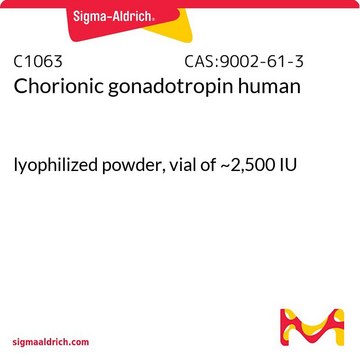L9773
Luteinizing Hormone from equine pituitary
pkg of ~15 units/vial
Synonym(s):
ICSH, LH, PLH
Sign Into View Organizational & Contract Pricing
All Photos(1)
About This Item
form:
powder
Recommended Products
form
powder
Quality Level
packaging
pkg of ~15 units/vial
solubility
water: 50 mg/mL, clear to slightly hazy, colorless to faintly yellow
UniProt accession no.
shipped in
ambient
storage temp.
2-8°C
Gene Information
horse ... LHB(100054774) , LHCGR(100034043)
Application
Luteinizing hormone (LH) has been used to study effect of LH on the development of preantral follicles for nuclear maturation of ovine oocytes and as an endocrine signal to study circadian phase in the ovary.
Biochem/physiol Actions
Two chain glycoprotein hormone, the α-chain is not active, biological specificity is attributed to the β-chain; induces ovulation, spermatogenesis, and synthesis of sex steroids.
Packaging
Package size based on NIH standard LH-S1 using the rat Leydig cell assay
Quantity
One NIH LH-S1 unit = approx. 2,000 I.U.
Signal Word
Danger
Hazard Statements
Precautionary Statements
Hazard Classifications
Repr. 1B
Storage Class Code
6.1C - Combustible acute toxic Cat.3 / toxic compounds or compounds which causing chronic effects
WGK
WGK 3
Flash Point(F)
Not applicable
Flash Point(C)
Not applicable
Personal Protective Equipment
dust mask type N95 (US), Eyeshields, Gloves
Choose from one of the most recent versions:
Already Own This Product?
Find documentation for the products that you have recently purchased in the Document Library.
Nuclear maturation of ovine oocytes in cultured preantral follicles
G Tamilmani
The Journal of Small Animal Practice (2005)
Timing of the Ovarian Circadian Clock Is Regulated by Gonadotropins
Tomoko Y
Endocrinology (2009)
Tomoko Yoshikawa et al.
Endocrinology, 150(9), 4338-4347 (2009-06-13)
The timing of ovulation is critically important to the success of reproduction. Current thinking attributes the timing of ovulation to LH secretion by the pituitary, itself timed by signals from the hypothalamus. The discovery of an internal circadian timer in
Hidetoshi Hasuwa et al.
Science (New York, N.Y.), 341(6141), 71-73 (2013-06-15)
Ovulation in the mouse and other mammals is controlled by hormones secreted by the hypothalamo-pituitary-ovarian axis. We describe anovulation and infertility in female mice lacking the microRNAs miR-200b and miR-429. Both miRNAs are strongly expressed in the pituitary gland, where
Rachel Y Cheong et al.
Endocrinology, 155(4), 1418-1427 (2014-01-31)
The negative feedback mechanism through which 17β-estradiol (E2) acts to suppress the activity of the GnRH neurons remains unclear. Using inducible and cell-specific genetic mouse models, we examined the estrogen receptor (ER) isoforms expressed by neurons that mediate acute estrogen
Our team of scientists has experience in all areas of research including Life Science, Material Science, Chemical Synthesis, Chromatography, Analytical and many others.
Contact Technical Service









